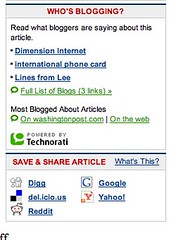The New York Times reports this morning that wireless carrier T-Mobile has launched a trial in Seattle of phones that use both cellular and wireless internet connections, which could improve reception in areas of weak cellular signals while enabling users to stretch their cellular minutes.
The first phones, which are available to consumers in Seattle on a trial basis, link to T-Mobile’s cellular network outdoors and to Wi-Fi routers at homes, in offices and in other locations like airports and hotels. This lets customers avoid using some of their cellular minutes and increases coverage in places where signals are typically weak, like basements and rooms without windows.
To gain access to the service, called T-Mobile HotSpot @Home, customers must buy a phone that works on both networks. T-Mobile is selling a choice of two handsets that cost $49.99 for customers who sign up for a two-year rate plan for at least $39.99 a month. Subscribers are charged $19.99 a month in addition to their regular cellular plan fees.
The dual-use phone service may appeal most to younger consumers who do not have a traditional phone line and rely solely on cellular phones and broadband lines.
“For the below-30 age segment, it’s a no-brainer,” said Roger Entner, a wireless industry analyst at Ovum, a consulting firm. “This is also a threat for other wireless carriers because it fixes the problem of poor coverage inside homes.”
When my two oldest children went away to college last year, cell phone reception in their dorm rooms was spotty, to put it charitably. Even though we had free in-network mobile-to-mobile minutes, we found ourselves needing to call their land line to get a clear connection.
Vonage’s advertising has been creative and memorable, particularly spot in which the circling dorsal fins near the beach lead the young lady to exclaim: “The dolphins! Let’s go play with the dolphins!” It’s also led to some creative spoofs:
[youtube=http://www.youtube.com/watch?v=t2B4jjt6Tvk]
A phone that uses wi-fi wherever you find it (not just at home) and can use cellular signals when necessary looks even more like “a smart decision in a sea of stupid ones.” I can’t imagine how this trial won’t be popular and successful, particularly since it may reduce T-Mobile’s need to invest in more cellular towers.
Mobile VoIP is one more reason to get rid of the land line, as our family did last year. Some people will opt for DSL, while others will use cable. In the not-too-distant future, there will be no need for anyone to have both.
And with some communities going to city-wide Wi-Fi, it all comes down to lots more competition for the telcos. The Times says Sprint is working to develop a similar service. If this experiment works in Seattle, imagine how well it will go over in a Wi-Fi city like Philly.
 Technorati: T-Mobile, Wi-Fi, Wireless, Vonage, Cell Phone, VoIP, DSL, Sprint
Technorati: T-Mobile, Wi-Fi, Wireless, Vonage, Cell Phone, VoIP, DSL, Sprint
 Technorati: Ragan, PR, Social Media
Technorati: Ragan, PR, Social Media
